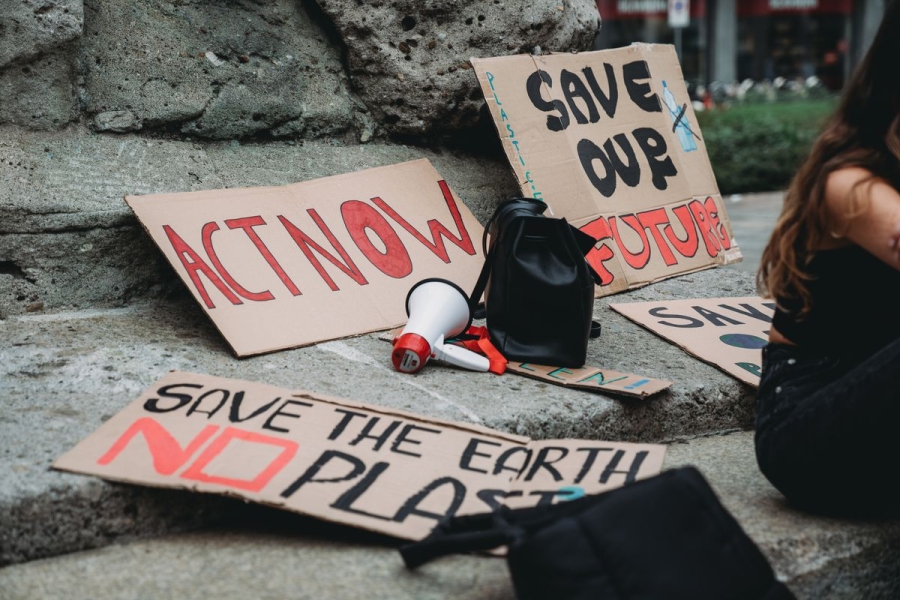A climate psychologist explains how we’ve moved beyond hope, anger, and complacency toward something more promising.

Rebecca Leber is a senior reporter covering climate change for Vox. She was previously an environmental reporter at Mother Jones, Grist, and the New Republic. Rebecca also serves on the board of the Society of Environmental Journalists.
Our actions today will determine just how bad climate change will become. But which emotions best drive a person to become politically active? Hope? Anger? Persevering through complacency? What if the fundamental challenge is actually our attention?
This last question gets at a particular theory in psychology that has undergone a revolution in the past few years. It’s a hypothesis called the “finite pool of worry,” coined in 2006 by Elke Weber, a psychologist and Princeton University professor. It states that people can only handle so many negative events at a time. So when public concern about one issue rises, another concern should fall. The theory gained attention after the 2008 financial crisis for explaining why heightened economic worries led the public to tune out on climate.
But in the last few years, something wonkier has been going on. Polling did not find that concern about climate change shrank when the global Covid-19 pandemic hit in 2020, as theorists would have expected; it actually grew. According to researchers at Yale University and George Mason University, public understanding of the science that human activity is warming the planet increased in 2020, and has roughly maintained those levels since. The issue has especially risen in importance among Democratic voters, who overwhelmingly view climate change as a major threat.
Weber herself recognized her theory needed revising after studying the Covid effect, and so did other researchers studying other countries. One of these researchers is Lorraine Whitmarsh, an environmental psychologist at the University of Bath, who co-authored a paper in 2021 that found “very little evidence” to support the hypothesis on the finite pool of worry for climate change.
I asked Whitmarsh how they might now think about public views on climate change. Understanding what drives people to take action on climate change is a specialty of Whitmarsh’s, and we spoke about how the range of emotions people may experience influences behavior. The interview below has been edited for length and clarity.
Rebecca Leber
The finite pool of worry made a lot of intuitive sense to explain why concern about climate change would change over time. When did it become clear there were cracks in the theory?
Lorraine Whitmarsh
There was quite a lot of broader psychological research to support this idea that people can only worry about a limited number of things at one time — whatever is top of mind. There’s this cognitive bias called “the availability heuristic,” which means that I’m only going to be worried about something that occurred in the recent past.
Over the past 20 or 30 years, media coverage had a strong agenda-setting effect on the issue. Polling suggested concern about climate change would wax and wane with whatever was in the news media, and to some extent, people’s own experiences.
We hypothesized that the pandemic logically should completely displace concern about climate change. It’s a massive crisis, everybody’s worried about it, so surely, we don’t have enough worry left for climate change. But we found throughout the polling that we did over the last few years, concern was either maintained or at various points even grew. It seemed like Covid was not displacing concern about climate change.
Rebecca Leber
How should we interpret this?
Lorraine Whitmarsh
Now, climate change seems to be a core worry — it has moved from the periphery to the core.
Climate change is reinforced regularly by what’s in the media and people’s direct experiences. I think the finite pool of worry theory needs a bit of nuance, distinguishing between core worries and peripheral worries.
Rebecca Leber
Your study on the finite pool of worry relied on a mix of social media and polling to determine how the public was feeling about climate change. Which method do you consider to be a more accurate reflection of public opinion?
Lorraine Whitmarsh
Neither polling nor social media gives a complete view. Social surveys are self-reported, so they will be partly people wanting to promote this image that they are a good person. And there will be other relevant factors — what’s the temperature at the moment? What have people just said to me that will influence how you’re feeling at that point in time, and how are the questions asked? There are lots of factors that will mean you’re only getting a partial view of what people really think. And particularly if you’re interested in behavior, then it’s very limited because people will say they do things and there will often be that gap between what they say and what they do.
Social media gives a different view, in that you’re seeing what people are actually saying without it being constructed by the researcher. In that sense, it’s more objective, but it’s a subset of people with usually very strong views, constructing a particular media for a particular audience. It’s a distorted view, but it’s one particular insight into what society’s thinking. But bringing them together is really valuable because while they’re limited in their own ways, together they can tell you something.
Rebecca Leber
If climate change has moved from a peripheral to a core issue for many people, wouldn’t repeat disasters cause more fatigue or complacency? Is there the risk that we adjust to heat, wildfires, and worse storms as the “new normal” and the climate crisis becomes easier to ignore?
Lorraine Whitmarsh
The issue of habitation — the more that we experience something, the more we get used to it — is a competing idea to the availability heuristic.
These extreme weather events are still periodic events. It seems unlikely in the near future that they would be so regular that we would completely habituate. We do have these fluctuations in people’s concerns, like when we’ve had some extreme weather events. During those moments, concern about climate change does seem to go up.
Rebecca Leber
So, what I’m hearing is rather than worrying about bumming people out, we should all be talking about climate change even more.
Lorraine Whitmarsh
There’s something called the “mere exposure effect,” that the more people see and hear something, the more it becomes relevant and something that they need to pay attention to. That’s why advertising works. To some extent, it’s just showing the same thing 1,000 times and when they are in a situation, they’ll be familiar with it.
With climate change, we absolutely need to break the spiral of silence. We need to embed it much more in discussions so that people can see that this is something that isn’t going away. The climate crisis is not just relevant when there’s a drought or another extreme weather event; we need to have it on the agenda when we’re talking about energy issues and air quality issues and everything else.
There’s also a big role for government here to really put climate change on the agenda and talk to the public so that there’s a societal dialogue happening about what are we going to do about climate change and showing people what they can do to be part of the solution.
Rebecca Leber
Unfortunately, real solutions aren’t always accessible for people. So maybe they’re trying to grapple with burnout and a learned helplessness.
Lorraine Whitmarsh
There’s a huge amount of research that shows just giving people information by itself does very little to change behavior. It might change people’s attitudes a bit. It might inform them, educate them, and motivate them to want to do something. But it often doesn’t actually turn into behavior change because there will be barriers like cost and convenience. Those barriers tend to be reduced by policy action like incentives and disincentives, regulations, as well as what businesses can do to make products attractive and cheaper.
A lot of that is policy; it’s what governments can do. That might be making low-carbon options cheaper, for example, and making them more available. It might be changing social norms so low-carbon consumption is seen as aspirational as opposed to a sacrifice or deviant.
Rebecca Leber
I’d like to hear your thoughts on a recent study published in the scientific journal Global Environmental Change that surveyed 2,000 Norwegian adults on how they felt about climate change. One of their findings was that anger was the strongest emotion associated with driving people to take part in a protest.
How important is anger in driving collective action?
Lorraine Whitmarsh
We know emotions are a really important driver of people’s behavior. But it is still true that while anger might motivate climate activism, which is one subset of behavior, we also need to engender some sense of hope and agency.
There’s a compelling example in trying to get people to reduce health risk behaviors such as smoking and having unsafe sex: What health psychologists found is that attempts to influence change can backfire when you talk about the risks but you don’t pair that with a message of what they can do about it. People will just ignore the bad news unless they’re given some sort of action strategy to tackle it. Really it’s more about self-efficacy — there is something you can do — than of hope.
People will find it harder to tackle climate change than to protect their own health, so we absolutely need self-efficacy and a message of why you should care. Maybe making people angrier, too.
Rebecca Leber
This made me think about hope. Because the study, among other research, found a lot of complacency among respondents. Perhaps many of us are actually too hopeful and not angry enough?
Lorraine Whitmarsh
I really think that’s the big question. Are people unrealistically hopeful? There’s talk of collective delusion, and obviously, the Don’t Look Up movie was more or less about being ridiculously, overly optimistic and ignoring this risk at our own peril.
If you talk to scientists, they are much more worried than the public. That suggests that people are perhaps unrealistically optimistic and that it’s not yet clear how much will have to change, how serious the risks are, and how quickly those risks are accelerating.
Rebecca Leber
The realization of those things could lead to fear. Could that be a good thing?
Lorraine Whitmarsh
Fear often sits behind anxiety, and there’s been growing attention to climate anxiety. We don’t see that climate anxiety is really widespread among populations, but it is higher among younger people. Often it motivates action. What we found was that there is a positive relationship between climate anxiety and taking action to tackle climate change. Fear can be a motivator in the same way that we were just saying about anger.
Rebecca Leber
Do you have any advice for people who work and volunteer on climate who are dealing with intense emotions?
Lorraine Whitmarsh
It can be really overwhelming to be thinking about this all the time. Obviously, there are things you can do like taking time out, but what’s very likely to help people is taking action to feel they’re making some progress. They’re taking back control. If you can do that with other people, then you’re more likely to feel that collectively you’re going to make a difference.
Source: vox.com






